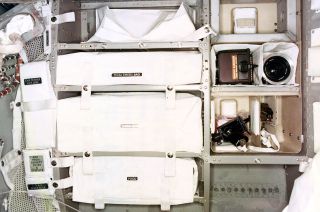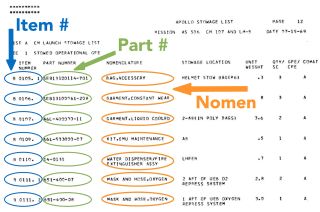Smithsonian Seeking Space Fans to Retype Apollo Spacecraft Packing Lists

Are you a fan of the Apollo moon landings? Are you curious about all of the different types of items that the astronauts carried onboard their spacecraft? Can you type?
If so, then the Smithsonian might have the perfect pastime project for you.
The National Air and Space Museum in Washington, D.C. has launched its first collaboration with the Smithsonian's Transcription Center to digitize the long lists of equipment that flew along with the Apollo astronauts from the Earth to the moon and back.
"Today, we are publicly launching an exciting initiative to transcribe the Apollo stowage lists of all government- and contractor-provided equipment stowed on the Command and Lunar Modules during the six Apollo missions to [land] the moon," wrote Allan Needell, a curator with the Air and Space Museum's space history department. "With the help of volunteers, these transcriptions will eventually lead to a reliable and searchable database." [NASA's 17 Apollo Moon Missions in Pictures]
As NASA and its contractors prepared each of the Apollo missions to launch, the space agency assembled master packing lists of what was being loaded on each capsule and lander and where exactly each item was being stowed inside. The lists went through several revisions up to just before the spacecraft left Earth, and included the plan for what was to come back, too.
Every toothbrush, camera lens, spacesuit glove and hand tool — among many, many other items — was identified in the stowage lists by part number, quantity, weight and in which locker or other location on the spacecraft (including sometimes on the crewmembers' person) where they were packed for launch. The lists also provided details for what items were to be transferred between the command and lunar modules during the flight and where they were to be restowed for the journey back to Earth (if they were in fact returning home and not being left on the moon).
The Apollo Stowage Lists (ASL) were a product of the late 1960s and early 70s, which meant that for the better part of the decades that followed, they were limited to printed copies. Since the advent of the internet, NASA's Johnson Space Center in Houston scanned the documents, but as images, the contents still could not be easily referenced by researchers and curators with regard to specific items.
Get the Space.com Newsletter
Breaking space news, the latest updates on rocket launches, skywatching events and more!
"They are extremely difficult to search or sort – whether by object name, part number, or spacecraft storage location," Needell wrote in a blog entry announcing the transcription project on Thursday (Nov. 12). "For a long time, we have dreamed of creating a searchable electronic database of this information."
Such a digital archive would help the museum's curators establish a more detailed history of the Apollo artifacts in the Smithsonian's collection.
"And, we hope, such a database, once we can develop a platform for sharing, will also prove invaluable to others, including those who will be tasked with the responsibility of developing policies for the treatment and possible recovery of Apollo artifacts currently residing on the moon," Needell said.
Space fans can now join the more than 5,600 volunteers already registered with the transcription center to begin re-typing the scanned Apollo Stowage Lists. The National Air and Space Museum staff already completed the Apollo 12 lists as a test of the system, but there still remains more than 1,000 pages of "as flown" Apollo equipment manifests to carefully transcribe and then review for accuracy and consistency before the Smithsonian begins its own review of the volunteers' work.

Step-by-step instructions are provided on the transcription center's website, including a more detailed description of the type and format of the data contained in the stowage lists. There is no cost to participate, you can do as much or as little as you would like and volunteers are welcome from around the world.
"The results of this [new] project will be a foundation for documenting the provenance and history of flown items, for future research related to those items and to others that may be offered to the Smithsonian and for augmenting our current and future exhibitions and displays," Needell wrote.
For more information, see the Smithsonian Transcription Center at: transcription.si.edu.
Follow collectSPACE.com on Facebook and on Twitter at @collectSPACE. Copyright 2015 collectSPACE.com. All rights reserved.
Join our Space Forums to keep talking space on the latest missions, night sky and more! And if you have a news tip, correction or comment, let us know at: community@space.com.

Robert Pearlman is a space historian, journalist and the founder and editor of collectSPACE.com, an online publication and community devoted to space history with a particular focus on how and where space exploration intersects with pop culture. Pearlman is also a contributing writer for Space.com and co-author of "Space Stations: The Art, Science, and Reality of Working in Space” published by Smithsonian Books in 2018. He previously developed online content for the National Space Society and Apollo 11 moonwalker Buzz Aldrin, helped establish the space tourism company Space Adventures and currently serves on the History Committee of the American Astronautical Society, the advisory committee for The Mars Generation and leadership board of For All Moonkind. In 2009, he was inducted into the U.S. Space Camp Hall of Fame in Huntsville, Alabama. In 2021, he was honored by the American Astronautical Society with the Ordway Award for Sustained Excellence in Spaceflight History.

